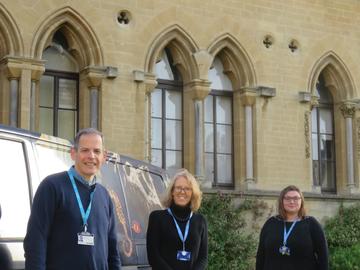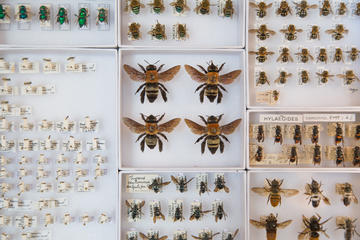
HOPE Learning Officers Rodger, Kate and Susie (left to right)
OUMNH
As part of our discussion on biodiversity we reached out to learn about the fascinating work of partners in “HOPE for the Future” project at the Oxford University Museum of Natural History (OUMNH). HOPE stands for 'Heritage, Outreach and Preservation of Entomology'. The British Insect Collection contains over a million specimens of all insect groups from butterflies, beetles and bees to flies to fleas. The project focuses on the intertwined heritage of the museum’s British Insect Collection and Westwood Room – originally called ‘Mr Hope’s Museum’ after Frederick William Hope, a founding collector of the museum in the 1840s. Hope’s museum-within-a-museum became a favourite meeting place for naturalists: Charles Darwin called Hope ‘my father in entomology’.
We met with three Learning Officers at the Museum of Natural History Rodger Caseby, Kate Jaeger, and Susannah (Susie) Glover:
Rodger: 'As part of the HOPE for the Future project, funded by the National Lottery Heritage Fund, we visit local schools, run activities at the museum, and create digital learning resources teaching children about the vital role that insects play in ecosystems and the importance of insect biodiversity. We show them how to investigate the insects found in their own school grounds, and practical ways to maintain rich habitats that support diverse wildlife populations.'
Susie: 'We are fortunate to be able to draw on the vast Hope collection of over 3.5 million British insects and the expertise of the collections team. Unique museum resources that we are able to share with children include insect specimens collected by Charles Darwin, and the peppered moths from Bernard Kettlewell’s study of natural selection.'

Bee drawer on display at the museum
OUMNH
When we talk about biodiversity, people often think about pandas, rhinos and whales. Why is this such an important collection and project?
Kate: 'What we hope to show children is that while insects may be small and seemingly insignificant, they are crucial to the health and sustainability of natural ecosystems. Historical collections can help us understand patterns of population change and which species are under pressure. Fostering a greater understanding of the natural world around us enables us to see ways in which we can help. School grounds and community green spaces can be hugely important habitats for wildlife.'
How do the children react to the collection?
Rodger: 'Sadly, we sometimes find that children have little opportunity to explore the natural world, especially in urban areas, and may even lack the words to describe the plants and animals we find. Nevertheless, they are always keen to learn. Questions like ‘Can you really age a ladybird by its spots?’ or ‘Do earwigs actually eat your brains?’ are starting points that lead to a fascination with the miniature insect ‘world’ we are able to reveal to them. Invariably, children respond by wanting to learn how to protect and sustain it.'
What is the most fascinating part of your role?
Kate: 'The most exciting part of the project is having the opportunity to share the rich diversity of British insects with young people and watching their fascination and enthusiasm grow.'
Rodger: 'It’s the sheer joy children show as they reconnect with nature. It makes work on the project such a privilege.'
Susie: 'I love the unexpected, frequently funny, and invariably insightful questions and observations that the children come out with. It helps me to see insects and the natural world from a different angle.'
How could the wider public learn more and enjoy the collection?
Rodger: 'We invite children to bring their families into the museum and complete an insect investigators trail exploring the insect exhibits. The museum is now open again and everyone is welcome to book free tickets to visit and find out more about the importance of insects in the upper gallery, just next to the café.'
Visit the OUMNH website for information on visiting the museum, and to view the HOPE project's online resources.